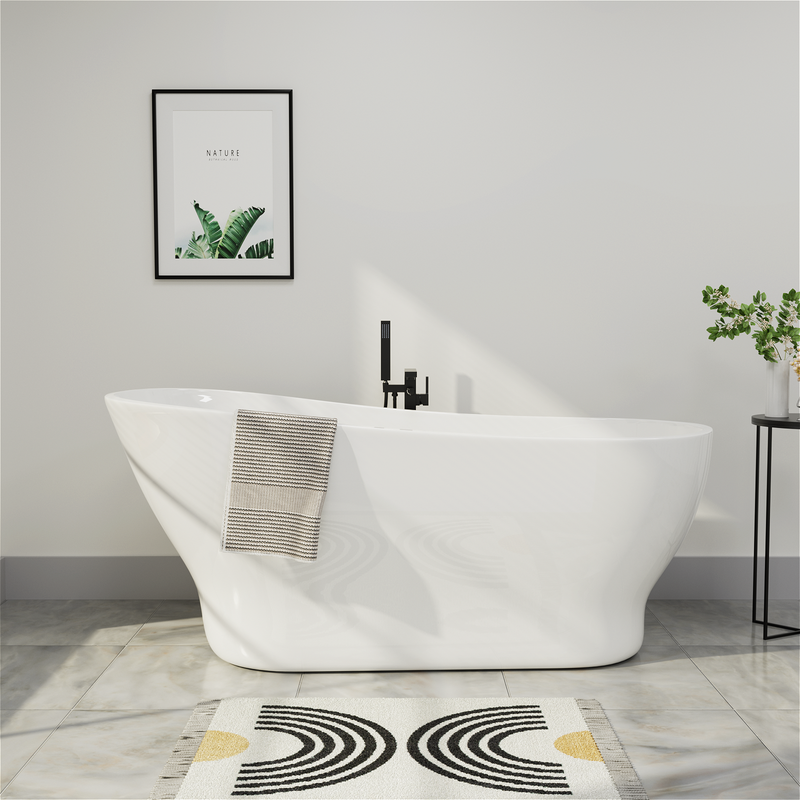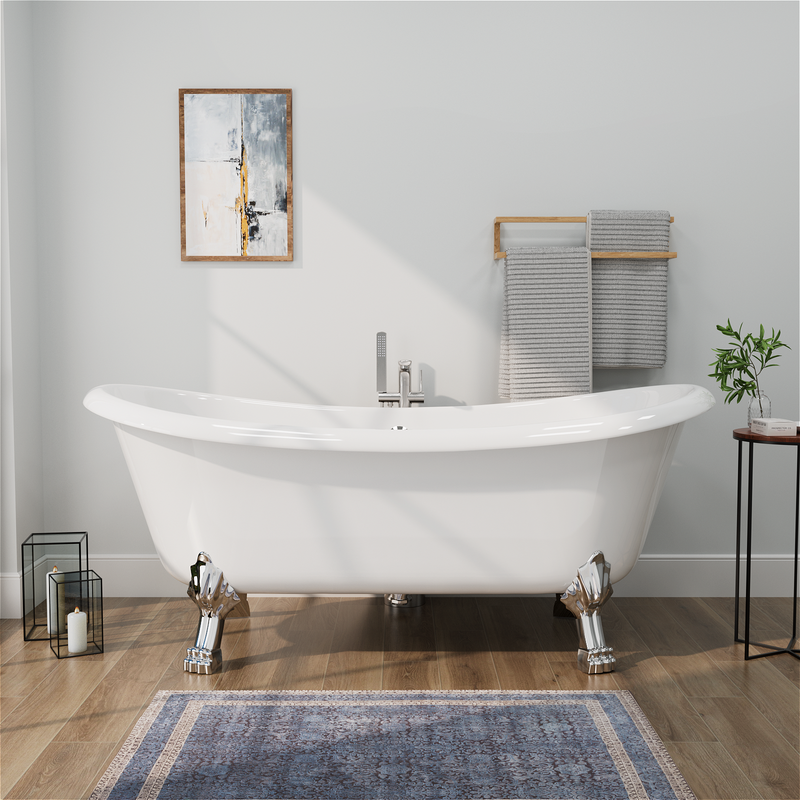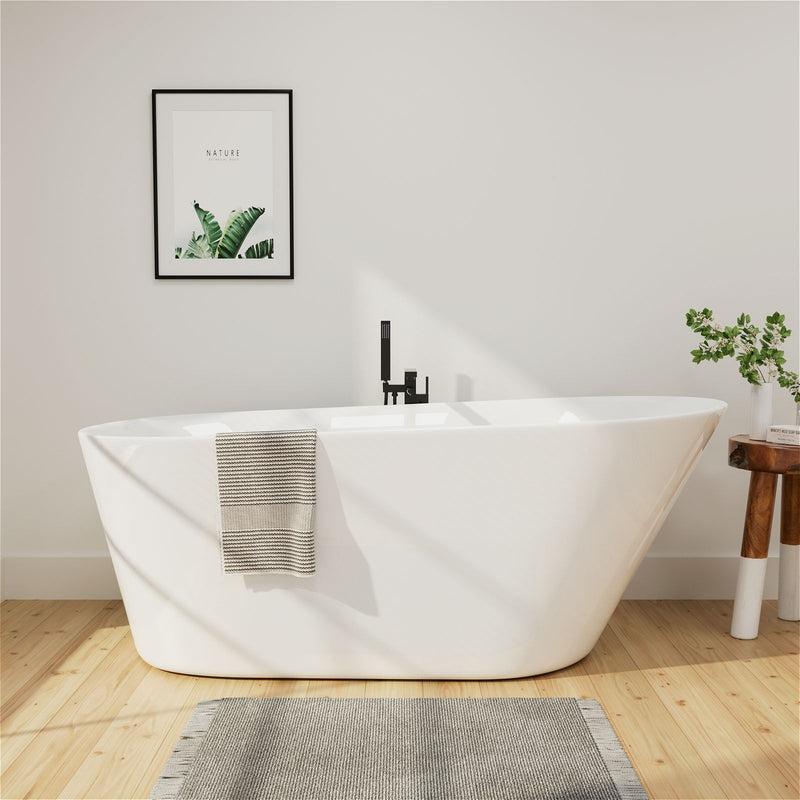A freestanding bathtub is more than just a functional fixture—it's the centerpiece of your bathroom, transforming ordinary routines into luxurious experiences. Among the various materials available, acrylic has emerged as a top choice for homeowners seeking the perfect balance of elegance, comfort, and practicality. Unlike heavy cast iron or brittle fiberglass, acrylic freestanding tubs offer a unique combination of lightweight durability, warmth retention, and design flexibility, making them ideal for both new constructions and bathroom renovations. This comprehensive guide will help you understand why acrylic freestanding bathtubs have become so popular and how to select the best one for your home.
Why Choose an Acrylic Freestanding Bathtub?
Acrylic freestanding bathtubs have gained widespread popularity for several compelling reasons. The material itself, polymethyl methacrylate (PMMA), offers properties that make it exceptionally suitable for bathroom fixtures. Unlike traditional materials, acrylic provides a warm-to-the-touch surface that feels comfortable against your skin, eliminating the initial chill of metal or porcelain surfaces when you step in. This characteristic, combined with excellent heat retention properties, allows for longer, more relaxing soaks without constantly adding hot water.
One of the most significant advantages of acrylic is its remarkable versatility in design. Through a process called vacuum-forming, acrylic sheets can be molded into various shapes, from classic oval and rectangular designs to more contemporary asymmetrical forms. This flexibility allows manufacturers to create elegant, flowing lines and ergonomic contours that fit the human body comfortably. Many acrylic freestanding tubs feature built-in lumbar support and textured bottoms for enhanced safety and comfort.
When it comes to durability, high-quality acrylic tubs reinforced with fiberglass offer surprising resilience. The material has a slight flexibility that allows it to withstand minor impacts better than more rigid materials like enameled steel or cast iron, which are prone to chipping. Modern manufacturing techniques include UV stabilization to prevent fading or discoloration over time, ensuring your tub maintains its appearance for years. With proper care, a quality acrylic freestanding bathtub can last 15-20 years or more.

From a practical standpoint, acrylic freestanding tubs are significantly lighter than their cast-iron counterparts, making them easier to install, especially in upper-floor bathrooms where weight might be a concern. Despite their lightweight nature, when properly reinforced with fiberglass backing, they offer excellent structural integrity and can typically support well over 300 pounds.
Maintenance is another area where acrylic excels. The non-porous, high-gloss surface resists staining and makes cleaning relatively straightforward. Unlike porous materials that can harbor bacteria and mildew, acrylic can be kept hygienic with simple, regular cleaning using non-abrasive cleaners.
Key Features to Look for in the Best Acrylic Freestanding Bathtub
Material Quality and Thickness
Not all acrylic tubs are created equal. The quality largely depends on the thickness of the acrylic layer and the reinforcement method. High-quality acrylic freestanding tubs typically feature a minimum thickness of 5mm, with premium models ranging from 8-12mm. Thicker acrylic not only feels more substantial but also offers better durability and heat retention. When evaluating options, look for terms like "high-gloss finish" and "reinforced with fiberglass" – indicators of a well-constructed tub that will maintain its appearance and structural integrity over time.
The manufacturing process also significantly impacts quality. Virgin acrylic material, as opposed to recycled content, typically results in a more durable surface that's less prone to discoloration. Some manufacturers offer additional protective coatings that enhance scratch resistance, an valuable feature for maintaining the tub's appearance with regular use.
Size, Shape, and Ergonomics
Freestanding acrylic tubs come in various sizes, from compact models around 60 inches long to spacious versions exceeding 70 inches. When selecting a size, consider both your bathroom dimensions and your comfort needs. The soaking depth is particularly important – look for models with at least 16-18 inches of depth for a truly immersive experience. Many premium models feature ergonomic designs with contoured backs and armrests, enhancing comfort during longer soaks.
Shape considerations extend beyond mere aesthetics. Oval designs offer a classic look and efficient use of space, while rectangular models provide a more contemporary aesthetic and often greater interior space. Unique asymmetrical designs can serve as striking focal points in larger bathrooms. Beyond appearance, consider how the shape affects entry and exit – some designs feature gradual slopes that make getting in and out easier, especially important for older adults or those with mobility concerns.
Stability and Installation Requirements
While freestanding tubs appear to stand independently, proper installation is crucial for safety and performance. Look for models with integrated support frames or reinforced bases that prevent flexing when filled with water. Some manufacturers include adjustable feet, which are particularly valuable in older homes where floors may not be perfectly level. These features not only enhance stability but also help prevent stress cracks that can develop over time if a tub isn't properly supported.
Installation considerations should include access to plumbing. Some freestanding tubs require precise placement of floor-mounted faucets, while others work with wall-mounted fixtures. Understanding these requirements beforehand ensures a smoother installation process. Additionally, consider the placement of the drain – center drains are common, but offset drains can sometimes offer installation advantages in specific bathroom layouts.
Additional Features
Modern acrylic freestanding tubs often include features that enhance functionality. Textured bottoms provide improved slip resistance, an important safety consideration. Some models offer integrated ledges perfect for storing bath products or candles. While not as common in freestanding designs as in drop-in models, some manufacturers incorporate heated surfaces that maintain water temperature longer – a luxurious touch that elevates the bathing experience.
For those interested in hydrotherapy, some acrylic freestanding tubs can accommodate air jet systems, though these typically require additional space for the machinery. If this is a consideration, look for models specifically designed with hydrotherapy in mind, as they'll have the necessary structural reinforcements to handle the equipment.
Installation and Maintenance Guidelines
Professional Installation Recommendations
While acrylic freestanding tubs are lighter than cast iron alternatives, proper installation remains critical for long-term performance. Before installation, ensure your bathroom floor can support the weight of the tub, water, and occupant – this may require consulting a structural engineer, especially in older homes. The subfloor must be perfectly level; an uneven base can cause stress points that may lead to cracking over time.

Plumbing considerations are particularly important with freestanding designs. Unlike alcove tubs that conceal plumbing in walls, freestanding tubs often require precise placement of floor-mounted faucets and drains. Many professionals recommend installing access panels or ensuring that at least one side of the tub remains accessible for future plumbing maintenance. The tub should be positioned with a slight tilt toward the drain to ensure complete water evacuation when draining.
During installation, avoid letting the tub rest directly on hard surfaces without appropriate padding. Many installers recommend using a bed of mortar or specialized foam support to create full contact with the subfloor, preventing flexing and potential cracking. Always follow the manufacturer's specific installation guidelines to maintain warranty coverage.
Maintenance and Cleaning
Proper care extends the life and appearance of your acrylic freestanding tub. For routine cleaning, use a soft cloth or sponge with mild, non-abrasive cleaners. Avoid harsh chemicals, abrasive pads, or brushes that can scratch the glossy surface. A mixture of baking soda and water works well for most stains, while a vinegar solution can address hard water deposits.
After each use, rinsing the tub with water prevents soap scum buildup. For deeper cleaning, specially formulated acrylic tub cleaners are available that clean without damaging the surface. Never use products containing acetone or other strong solvents, as these can permanently damage the acrylic finish.
To maintain the tub's appearance, avoid placing sharp objects directly on the surface, and use mats with non-abrasive suction cups if additional traction is desired. With proper care, a high-quality acrylic freestanding tub will maintain its glossy appearance for many years, requiring only occasional polishing with specialized products to address minor surface scratches.
FAQs About Acrylic Freestanding Bathtub
Q1: How does acrylic compare to cast iron for freestanding tubs?
A: Acrylic offers several advantages over cast iron, including significantly lighter weight (making installation easier, especially in upper-floor bathrooms), warmer surface feel, and greater design flexibility. While cast iron excels at heat retention, high-quality acrylic provides excellent insulation properties. Acrylic is also less prone to chipping than enameled cast iron and typically comes at a more accessible price point.
Q2: Are acrylic freestanding tubs durable enough for daily use?
A: Yes, high-quality acrylic tubs reinforced with fiberglass are designed to withstand daily use. Their slight flexibility makes them less prone to impact damage compared to more rigid materials. Proper installation with full support is key to preventing stress cracks. With appropriate care, a quality acrylic freestanding tub can last 15-20 years or more.
Q3: Do acrylic tubs scratch easily, and can scratches be repaired?
A: While acrylic can develop surface scratches if abused, high-quality models have hard surfaces that resist everyday wear. Minor scratches can often be polished out with specialized acrylic polishing compounds. For deeper scratches, professional repair kits are available that involve filling and refinishing the affected area. Using proper cleaning tools and avoiding abrasive cleaners significantly reduces scratching risk.
Q4: How is the heat retention of acrylic compared to other materials?
A: Acrylic provides excellent heat retention, superior to steel tubs and comparable to cast iron in many cases. The material feels warm to the touch immediately, unlike metal surfaces, and its insulating properties keep water warmer longer. Some manufacturers enhance this natural insulation with additional layers in the tub construction.
Q5: What weight can a typical acrylic freestanding tub support?
A: Quality acrylic freestanding tubs, when properly installed on a supportive base, can typically support well over 300 pounds. The exact weight capacity varies by model and design, so always check manufacturer specifications. Structural reinforcements like fiberglass backing contribute significantly to weight capacity.
Q6: Are there special requirements for installing a freestanding acrylic tub?
A: The main requirements include a level and structurally sound subfloor, appropriate plumbing connections for freestanding designs (often requiring floor-mounted faucets), and adequate space around the tub for cleaning and access. Unlike built-in tubs, freestanding models need consideration of all sides for both aesthetic appeal and maintenance access.
Conclusion
Choosing the best acrylic freestanding bathtub involves considering multiple factors, from material quality and size to installation requirements and maintenance. Acrylic's unique combination of warmth, lightweight durability, and design flexibility makes it an excellent choice for most bathroom settings. When selecting your tub, prioritize thickness (5mm or greater), reinforced construction, and ergonomic design features that enhance comfort and safety.
Remember that proper installation is just as important as the tub quality itself. Ensuring a level, supportive base and correct plumbing connections will maximize your tub's lifespan and performance. With appropriate care and maintenance, a high-quality acrylic freestanding bathtub will serve as a beautiful and functional centerpiece in your bathroom for years to come, transforming daily routines into luxurious retreats that add both comfort and value to your home.





